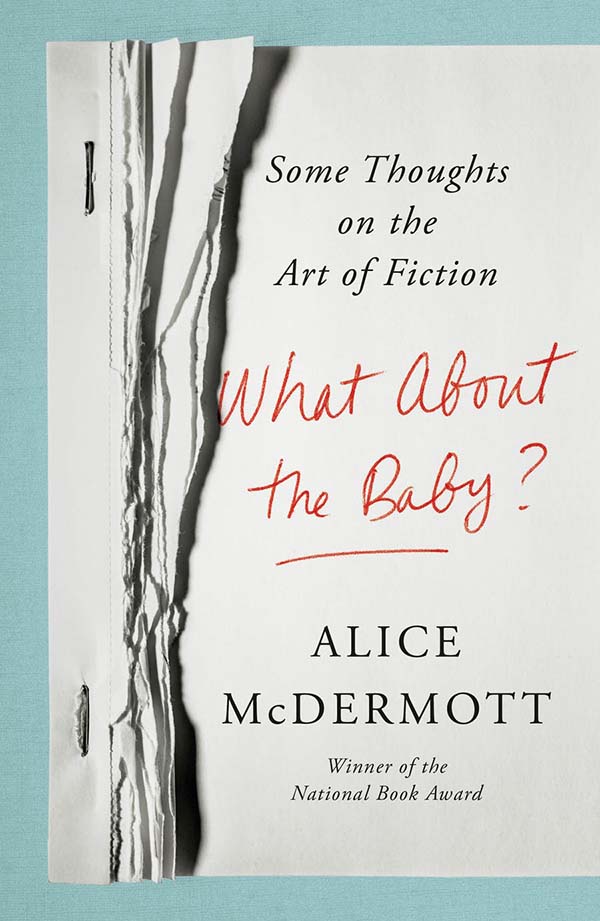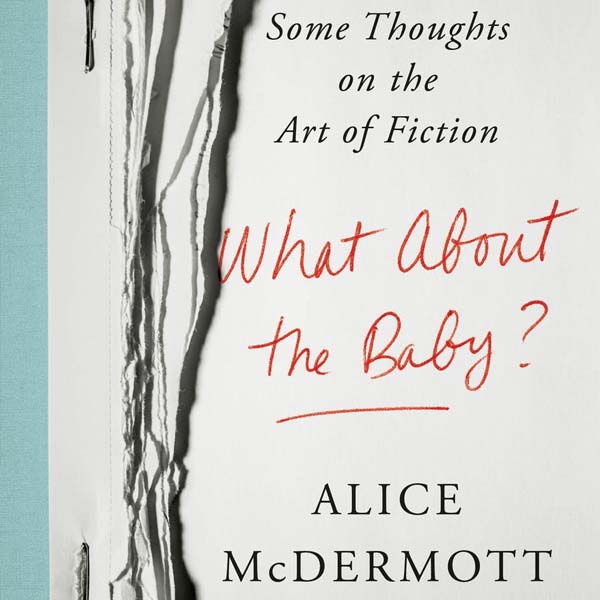What About the Baby?: Some Thoughts on the Art of Fiction

Alice McDermott has been my favourite living novelist ever since I picked up After This in 2014. Though a distinguished and award-winning author, McDermott’s name is not often included among the canon of Christian literary luminaries such as Flannery O’Connor, Walker Percy, Frederick Buechner, Wendell Berry, and Marilynne Robinson. But now, like O’Connor and Buechner, McDermott has offered the world a work on how to write and reflections on the writer’s craft. Along the way McDermott interacts with a host of lauded fellow writers, including Leo Tolstoy, Vladimir Nabokov, and E.M. Forster.
McDermott marvels at the ways in which good fiction and individual lines, characters, or scenes can “come back to me - unbidden sometimes,” sometimes long after we have first read them (p. 17). McDermott relishes the way that stories tell us, show us, who we are yet at the same time she desires that “fiction...be truer than life - yours, mine, everybody else’s - truer than reportage, lecture, memoir, or sermon, so that we, its readers, might listen with our whole being...I expect this because I want the fiction I read not only to recognize the infinite value and variety and worth inherent in the human soul, the human character, I want it to help me to believe in this infinite variety and value when ‘real’ life seems so determined to prove otherwise. I want to believe that we human beings are, all of us, of equal value and depth and complexity when we stand naked talking into the dark despite how readily, hourily, life presents us with fellow human beings who make us doubt this premise - fellow human beings we suspect we would prefer never to hear or to see in such circumstances (naked, that is, talking into the dark,” pp. 12-13). At times we can struggle to understand our neighbour or “the other” - how can they believe X? Why do they do Y? Literature, through its careful development and empathetic treatment, can help us better understand those who are different from us as we are introduced to characters from walks of life miles away from our own. My own eyes have been opened to the immigrant experience through the short stories in Souvankham Thammavongsa’s collection How to Pronounce Knife, which won the 2020 Giller Prize.
McDermott counsels writers to pay careful attention to objects, to things, to words. In analyzing a passage from Leo Tolstoy’s Hadji Murad she notes that “Clarity is achieved by careful use of detail - detail of place, detail of face, of dress and sound and smell and gesture. It is achieved by taking our time to get the sentence right, by eliminating the distractions of useless words and superfluous clauses, by having the courage to aim straight at our meaning rather than dance around it or bury it in pretentious obscurities. By taking our time, sentence by sentence, to develop a scene. By taking our time, sentence by sentence, to evoke a world and the creatures who inhabit it” (p. 165). McDermott notes that every object has “the potential to stir a memory, evoke a metaphor, conjure a ghost, reflect an ultimate reality,” that every object mentioned or described has been intentionally mentioned or described by the author and, as such, can contain significance and meaning (pp. 211-12).
There are more writerly tidbits that McDermott provides, such as the necessity of ending a novel well (“A good ending...sends us forward, much as a good beginning does...But a good ending also casts a light back through the novel, back to the first chapter and scene and word,” p. 38), the importance of a story’s first sentence to define a tale (“the first sentence of a piece of fiction serves as much more than a searchlight or hook or even lure to the reluctant reader. The first sentence in a work of fiction places the first limitation on the utterly limitless world of the author’s imagination. Before the first sentence is composed, anything is possible,” p. 43), avoid overusing semicolons and rely primarily on the simple past (p. 59), and the power of writing with authority; your characters shouldn’t be dithering and doubtful but should express themselves with the confidence you would expect from someone who would take your hand to show you their world (p. 48). She urges writers to continuously reread what they’ve already written so as to find the significant and not-so-significant details that add texture to their characters and their development (p. 102). She observes that many writers are torn between the reality of a literary inheritance, a tradition “formed by thousands and thousands of stories not our own, told in voices not our own, the very stories we study and emulate and love” while at the same time wanting to pioneer something new for “our stories are unique, uniquely ours, because the lives we have lived that have led us to these stories, to the very words with which we tell them, will never be duplicated” (p. 64).
I have read several books on writing and in each one the author surprises me with an iconoclastic take that upends what I learned in school. In McDermott’s case, she advocates that in many cases it is better to tell than to show. She chides eager writers who need to needlessly weave a character’s detail into the story through some subtle or symbolic aside; rather than construct some elaborate circumstances where a gesture or words tips towards significance, just tell us the protagonist met his wife in Bavaria, rather than tortuously revealing this to us as the protagonist scans his menu at a German restaurant and glances upon schnitzel and Gewürztraminer, evoking memories of that fateful first meeting with his wife on a blustery day in the halls of Neuschwanstein (p. 191)! As opposed to some writing veterans who counsel aspiring writers to simply put pen to paper and write, regardless of the quality of the writing (that’s what refining and editing is for), McDermott stresses that writers should stress over words - “Words matter...they’re all we’ve got, and if you’re not suffering over every one of them, you’re in the wrong profession. Write a blog, not a novel...Try Twitter, not poetry” (pp. 124-25).
McDermott believes a novel can be “unsatisfying” if it is without “a moral vision” (p. 38). This earned her the ire of an editor earlier in her career who contended that stories did not need to have moral visions but McDermott counters that even though a moral vision might seem antiquated and dogmatic, “it’s as much a part of what we look for in the ending of a novel or a story as cleverness, magic, and Aristotle’s consistent whole. Put simply: We look for what the novel says that’s true for us all. We look for us” (pp. 38-39). Related to this, McDermott examines her own revulsion towards the spree of rape scenes and female homicides in Roberto Bolaño’s lauded last novel, 2666, wondering “if I hated stumbling upon these rape scenes not because they were (artistically?) gratuitous or (morally?) misogynistic, but because I believed in the lives of these discarded women and girls more fully than their authors did” (p. 75). McDermott notes that women in her classes no longer feel as if they are able to write “chick lit” because readers are drawn to the darker content of 2666 and other stories, to the masculine voice; “A woman narrating the story of her life with an annoying boyfriend was chick lit. A man narrating the story of his life with an annoying woman was, well, literature” (p. 76). Thankfully, through her own novels, McDermott witnesses to the richness and depth that we can glean from stories not of grim serial killers or marriage-shattering scandal but of nuns in early twentieth century Brooklyn or the unremarkable, undramatic Marie of Someone whose life is nevertheless filled in the ordinary ways that yours and my life are.
My favourite essay in this collection is “Faith and Literature.” As mentioned, McDermott is a Catholic writer (in her own words, not a very good one) and I appreciated her sustained reflections on faith and literature. It seems to me that when she enthuses that story offers readers a “shimmer of magic...A magic that allows us to see, to recognize, what we have never seen before. To marvel at the familiarity of the conjured world even as we glimpse the never-before-seen enchantment of it all” (p. 34), one can also glimpse the religious side to this - not magical, but sacramental, where ordinary objects like water and oil, bread and wine, are channels of God’s grace. She writes of how the Roman Catholic Church has provided her characters, often very ordinary individuals, with expressions, with language, they would not be able to convey on their own - rich and meaningful words like “mercy” and “intercession” (pp. 169-70). McDermott explains that “The Catholic Church gives my characters words for what they feel but cannot speak, much as a poet might do for the general population. I write about Catholics because the promises of Christianity speak to the longing my characters feel as they make their way through their lives, the simple and consistent longing to make sense of suffering, of loss, of love, of their own shakeable feelings of exile and hope” (p. 170). She adds “I write about Catholics because I am one, a cradle Catholic, and so I know the language and the detail. This saves me from having to do too much research. There’s nothing more rewarding than spending hours and hours on the internet, picking up all kinds of historical or cultural tidbits, and nothing more deadening to one’s prose than the determination to insert those interesting tidbits into a story, whether the story needs them or not. I write about a culture I know fairly well in order to resist the siren song of research - the procrastinating writer’s best excuse for avoiding the far more difficult working at words” (p. 170).
McDermott has not shied away from commenting on the affairs of the Catholic Church and she laments the epidemic of sexual abuse that has engulfed so many victims. Yet she also reflects that “Those of us in the narrative arts need struggle and strife, the whole gamut of human failings and aspirations, all vice as well as all virtue. Disbelief as well as belief. As [Flannery] O’Connor points out...the Church was founded on Peter, who denied Christ three times and could not walk on water. Why are we expecting perfection from his successors?” (p. 174). Again, I don’t take McDermott as being glib or flippant when grieving the dark side of the Catholic Church’s legacy, but she also points out that all human beings have the capacity for evil and for good.
Writing about the life of Mother Teresa and of that modern saint’s struggle with belief, McDermott questions whether it was appropriate for the letters Mother Teresa had “written on the advice of her confessor” to be published when her own desire was that they be destroyed (p. 176). McDermott muses that “A more interesting discussion might ensue were we to ask if we even believe that the inner life, the unexpressed [untweeted?] thought or emotion, has any value at all. Do we believe the inner life, unexpressed, even exists?) (p. 176). In a narcissistic age where Twitter users are tweeting their every random thought, where Instagram users are posting every random picture, where bloggers are writing long essays (or book reviews!), I appreciate McDermott’s reflection on the inner life, the life that we share with God and ourselves or, perhaps, a small circle of trusted companions, the life that needn’t be cast into the limelight for all to see.
A book on writing is, to me, like a cooking show. The host or competitor showcases the array of ingredients they are using and our mouths water at the finished meal. I want to eat it! McDermott has provided readers with the ingredients to craft a compelling story and her “finished meals,” her novels, tinged with grace, are inspirations to us, her readers.


